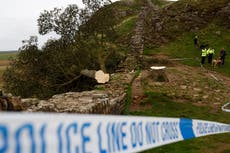From George I to Charles III, the Sycamore Gap tree saw British history unfold
Two world wars, multiple monarchs, disasters and jubilation: Sean O’Grady reflects on the rich history of the tree at Hadrian’s Wall – and explains why we shouldn’t flinch from mourning its felling


I’m not quite sure why trees can have such a powerful hold on us, but it’s a remarkable, almost spiritual phenomenon. We sense they are living things – often venerable, always graceful, occasionally of stunning beauty.
The sycamore that stood by Hadrian’s Wall for 300 years was chopped down in an apparent wanton – but surely premeditated – act of vandalism. As has been rightly observed, it was handsome enough to be a film star, and its performance in the 1991 version of the tale of Robin Hood was hardly wooden.
Seeing it lying there, stricken, helpless, slowly dying makes one irrationally depressed – it’s only a tree, you try to tell yourself. I’d never met the tree, after all. But, like many of us, it was a sad – even sickening – sight. To those who had some connection with it – a marriage, a scattering of ashes, a habitual resting stop – its loss is more akin to a bereavement. Many tears have been shed.
A 16-year-old was arrested by Northumbria police on suspicion of criminal damage on Thursday in connection with the incident. A man in his 60s was also arrested on Friday night. Out of curiosity, tinged with a touch of vengefulness, I consulted the sentencing guidelines. They read as follows: “The offence of criminal damage is an either-way offence [meaning it can be heard in the magistrates’ or Crown Court] which attracts a maximum sentence of 10 years’ imprisonment. Where the damage value is less than £5,000, the case must be tried summarily and attracts a maximum sentence of three months’ imprisonment and, or a fine of up to £2,500.”
And how much is an old tree worth? Its “market value” as timber or firewood? Not much. There is no accounting for the very real, and widespread, emotional distress inflicted by such an act as this – a kind of mental violence, and a violation of memories. Someone might call that sentimental and irrational, but it is how we humans roll. It hurts, and it matters.
I know it’s silly and anthropomorphic in a way, but you cannot help reflecting on what the sycamore “observed” since it was a sapling in the early 18th century – before Jane Austen had written her first novel, a century before Queen Victoria was born, and not that long after the English Civil War.
The tree, in a precarious gap, had survived countless assaults by nature including the great heatwave of 1911, the drought in 1976, the 1987 Great Storm and the freakish weather patterns of recent years. Not just two world wars, but the Napoleonic Wars and the revolt in the American colonies. It’s been there from George I to Charles III. It gave joy and solace to generations. Now it’s gone, and it, well, leaves a gap in every sense.
Obviously, we don’t value our trees enough. By that I mean the ones that will never get a Tree Preservation Order. The ones that the councils in Sheffield and Plymouth felled before people had a chance to object. The little copses along the border of the allotments, such as I used to enjoy before the holders there decided they cast too much shade over their precious crops, and got to play with their chainsaws.
There are few things more gruesome than the rasping, murderous sound of chainsaws lopping down trees that have stood for decades, provide natural beauty and a small haven for wildlife. Trees, as we are now reminded, are basically defenceless. No wonder the latest State of Nature report reveals that the UK is one of the most naturally denuded parts of Europe – nature under attack.
Climate change will surely make matters worse, and not just because of the extra stress it places on root systems. Invasive pests will spread more disease and damage, just as the oak processionary moth is doing to England’s national tree now. Worse still, more and more buildings will become threatened with subsidence from trees because of drier summers, wetter winters and more “heave” in the ground – something exacerbated as fine mature trees try to survive.
So more will be cut down to protect homes – completely understandably. But the tree at Sycamore Gap posed no such danger. It was thing of beauty, and our lives are the poorer for its passing. With that in mind, perhaps we should try and cheer ourselves up with this famous piece of verse, by Joyce Kilmer:
I think that I shall never see
A poem lovely as a tree.
A tree whose hungry mouth is prest
Against the earth’s sweet flowing breast;
A tree that looks at God all day,
And lifts her leafy arms to pray;
A tree that may in summer wear
A nest of robins in her hair;
Upon whose bosom snow has lain;
Who intimately lives with rain.
Poems are made by fools like me,
But only God can make a tree.
Join our commenting forum
Join thought-provoking conversations, follow other Independent readers and see their replies
Comments


Bookmark popover
Removed from bookmarks